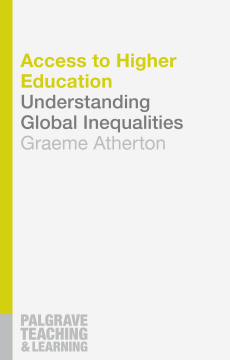
Additional Information
Book Details
Abstract
This book is the first systematic attempt to examine one of the biggest challenges facing universities and society in the 21st century: how do we create opportunities to allow people from all social backgrounds to benefit from higher education? It examines how policymakers, higher education institutions and civil society organisations are meeting this challenge across the globe. Each chapter focuses on one of 12 countries, including the economically powerful US and Germany, developing nations from Africa and South America and the new higher education 'superpowers' of China and India.
Access to Higher Education shows that across these different nations inequalities in higher education participation are common, but their nature differs. It argues for a new, 'nationhood' based approach to understanding why these differences exist.
Graeme Atherton is Head of AccessHE and Director of National Education Opportunities Network, UK. He has been active as a researcher, practitioner and manager in the field of widening access to higher education since 1995. He is also Visiting Professor in Higher Education and Social Mobility Practice at London Metropolitan University and has spoken in over ten countries on widening access including Australia, the USA and Canada.
This book is the first systematic attempt to examine one of the biggest challenges facing universities and society in the 21st century: how do we create opportunities to allow people from all social backgrounds to benefit from higher education? It examines how policymakers, higher education institutions and civil society organisations are meeting this challenge across the globe. Each chapter focuses on one of 12 countries, including the economically powerful US and Germany, developing nations from Africa and South America and the new higher education 'superpowers' of China and India.
Access to Higher Education shows that across these different nations inequalities in higher education participation are common, but their nature differs. It argues for a new, 'nationhood' based approach to understanding why these differences exist.
Table of Contents
| Section Title | Page | Action | Price |
|---|---|---|---|
| Cover | Cover | ||
| Contents | v | ||
| List of figures and tables | vii | ||
| Contributors | viii | ||
| Series editor’s preface | xiv | ||
| Introduction | 1 | ||
| 1 Canada – Access at the Crossroa | 13 | ||
| 2 Marching in the Rain: The TRIO Programme and the Civil Rights Legacy in the United States | 29 | ||
| 3 Access and Retention in Higher Education in Colombia: The Case of the Children’s University EAFIT | 43 | ||
| 4 Changing the Mindset: How Germany Is Trying to Combine Access and Equity | 55 | ||
| 5 Extending Equity in Higher Education in an Equitable Society: The Finnish Dilemma | 68 | ||
| 6 The United Kingdom: The Access-to-Higher-Education Nation? | 77 | ||
| 7 Access to Post-secondary Education in Malaysia: Realities and Aspirations | 94 | ||
| 8 Expanding Higher Education in India: The Challenge for Equity | 109 | ||
| 9 National Access Policies for Higher Education in China: Creating Equal Opportunities in Education | 121 | ||
| 10 Access to Higher Education in South Africa: Addressing the Myths | 137 | ||
| 11 Making Commitment Concrete: Policy and Practice in Access to HE in Ghana | 151 | ||
| 12 Evolution or Revolution: The Three Ages of Access in Australia | 164 | ||
| 13 Conclusions: The Age of Access | 182 | ||
| References | 192 | ||
| Index | 212 |
